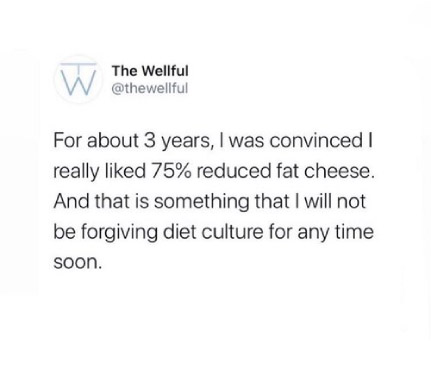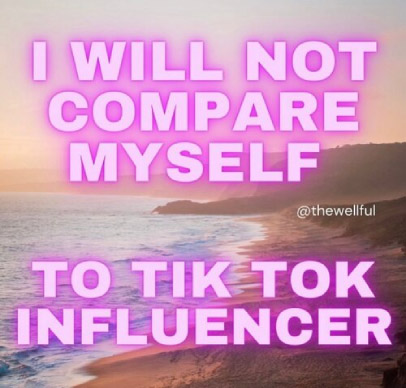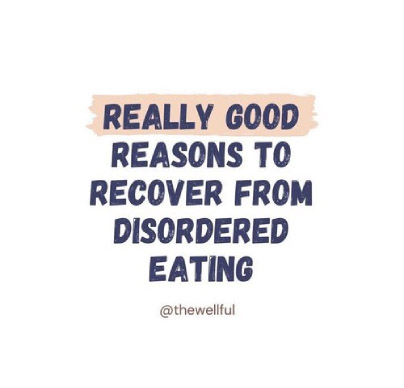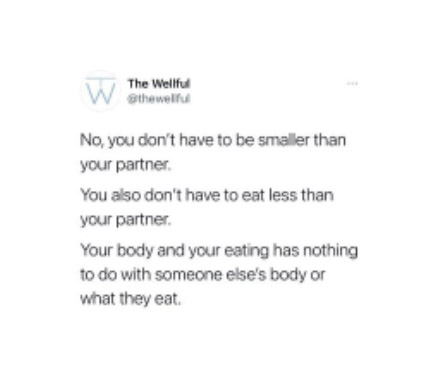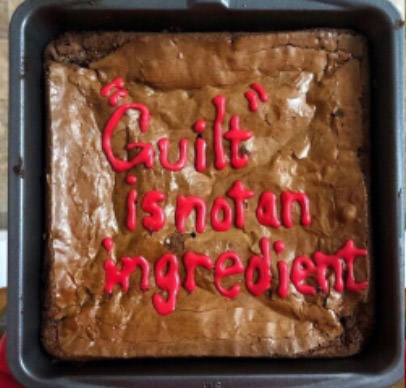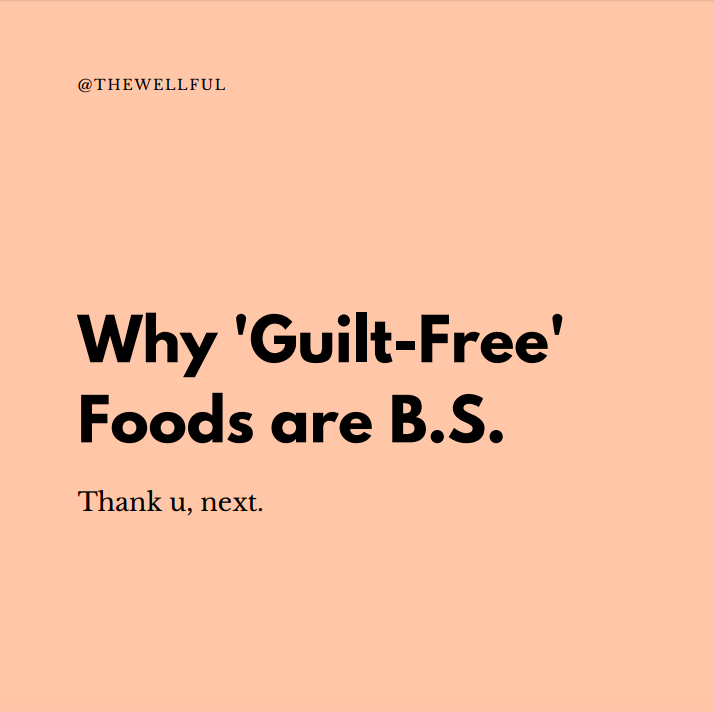
I spend a lot of my time in grocery store aisles. So much so that one time on a trip to Ireland, my family lost me for 30 minutes because I had found a health food store – I call it research.
I’ve also worked for startups – food, beverage and grocery store – so have been involved in the crafting of actual products and their messaging as well as seeing how customers react to them. When I worked in a boutique grocery in downtown NYC some customers wouldn’t buy products UNLESS they had calorie labels on them – even if they were made fresh from a restaurant next door. Others, would pick up $70+ worth of trendy supplements, weekly, and admit to not knowing what they were but that they recognized the name from Goop. Then there are the health-ified foods – that have added ‘protein’ or ‘healthy’ or ‘guilt free’ written into the brand name to let us know they’re okay to have! Thanks, marketing!
The punch line? There is a lot of nutrition messaging out there and at the end of the day, the goal of marketing is selling products – not to enhance your health or wellbeing.
What else? There is never ‘guilt’ as an ingredient. I promise. Go check the back of your favorite “guilty” food, it won’t be listed. When we label foods as ‘guilt free’ it makes it seem like we should feel guilt about foods that aren’t labeled guilt free. Yikes. What’s really happening is that the labeling of this product is using basic psychology and marketing principles to make you buy their product – but it’s also changing how you feelings and thoughts about food.
The research on the Health Halo – the idea that we make generalized assumptions about the health of a food based on a few trendy claims – isn’t new. In the past, we’ve studied a similar phenomenon in people, being that we assume when we meet a person who is physically attractive, we also assume that the are also social, friendly, fun, competent etc. (a discussion for another day). But newer research is showing that we make these same generalizations from claims on food packaging. Foods labeled as ‘low calorie’ ‘fair trade’ ‘organic’ ‘natural’ we infer that they are superior in many ways to their shelf competitors. But not just superior – we assume it’s overall lower in calories. With fair-trade chocolate bars, there was an assumption that they ‘fair trade’ version was lower in calories – even though the way chocolate is farmed and traded doesn’t have much to do with it’s caloric content – we assume it does based on the claim!
Here are a few marketing basics and how to spot them. Plus, some insight on what’s actually happening when we label foods as ‘guilt free’:
1. Framing other competitive brands or food products as GUILTY
Quick story: My brother recently moved to Bermuda for work and went to a new dentist there. While the dentist was introducing himself – doing his spiel – he touted to my brother, “And I want you to know, we’re very proud that all of our equipment is totally sterile and we check it before each patient – just like in the States!” Not only did this make my brother think about the possibility of non-sterile equipment being used but it also created doubt about other dentists in Bermuda! (and was a funny story) Point is: making a statement like this – even if it’s about something that didn’t cross your mind earlier, or that you already assumed to be true, creates doubt about other products that don’t advertise that feature.
Think about this: If a cereal box had a big statement “We ensure there is never any glass shards in our box – guaranteed!” You would see that and think “OMG – do other cereals have glass shards inside?!” Doubt, created.
2. It changes our behavior around those foods
Not only does it change your buying behavior but it also changes your EATING behavior. You’re more likely to have a greater amount of an item you label as ‘guilt-free’ than one you see as neutral. Research by Brian Wansink – a known leader in studying consumer behavior and marketing research – has shown that labeling a food as ‘low fat’ increased the consumption of that food by as much as 50%. Regardless of the amount more we may have – the idea is that when we see a food as ‘guilt-free’ we consume more of it than we would it’s ‘guilty’ competitor.
Claims → health halo → assumptions → increased consumption
When you tell someone that you made a ‘guilt-free’ dessert without flour (or another normal baking ingredient), they’ll probably say something along the lines of “okay so I can have twice as many now, right?!” That is exactly the messaging of Halo Top ice cream. Their packages tell you to “stop eating when you hit the bottom” since they are a ‘guilt-free’ dessert. It enforces the idea that we eat based on how guilty a food makes us or not – instead of things like taste, satisfaction, hunger, nutrition, what you’re in the mood for, all the WHYs and reasons we should be eating and enjoying foods!
About how much Halo Top would do you think you want because it’s labeled ‘guilt-free’ vs. how much would you want if it wasn’t labeled that way? Halo Top is appealing because it offers a ‘guilt free’ opportunity to have a larger amount of a food that we typically label as ‘guilty’ or ‘bad’.
Think about this: If you didn’t know the calories in Halo Top and had a blind taste test next to another ice cream, which would you choose, and how much do you think you’d be satisfied with?
3. It changes how the food tastes to you
This year, a French grocery chain created a video for Ad Week showing how customers were tricked into thinking popsicles and yogurts were different flavors based on their coloring alone. They were actually all the same flavor but red ones were guessed to be cherry or strawberry and orange ones were guessed to be apricot or orange – coloring can trick our brain into assuming taste! Similarly, when we are told that one food product is superior to another or no longer ‘off limits’ since it’s labeled ‘healthy’ or ‘guilt-free’ it can change our sensory experience with the food, making it taste better. Our positive assumptions about how healthy or good a food is for us, can also make us find it more palatable and enjoyable but if we were to step back and objectively compare them – we might not be so convinced.
Think about the first time you tried a diet-y food or made your friend try something like frozen yogurt instead of ice cream. They probably reacted with a bit of disappointment compared to the real thing, but with enough praise of how ‘healthy’ this alternative is and some convincing marketing might be able to get just as excited about the diet version. That’s marketing.
4. It disconnects you from your body
Believe it or not, your body is really, really good at guiding you to eat enough, choose nourishing foods and support your health. Yes, nutrition knowledge and understanding is helpful to guide that intuition, but it’s definitely there. So if you’re eating and choosing foods because of some flashy labeling or creative marketing – it’s hard to tell if you actually LIKE what you’re eating and if it even feels good to you. If you’re eating ‘til the bottom of Halo Top because it’s a ‘permitted food’, you likely aren’t paying attention to your increasing fullness, how satisfying it is, or if you’re even liking it! If we’re constantly ignoring those signals and eating until uncomfortable – albeit, ‘guilt-free’ – fullness, it makes it much harder for us to tune in and eat a satisfying amount of the real stuff and increases our dependence on filling up on the ‘guilt-free’ ones!
Some of the ingredients in real ice cream – like fat and milk – are what make ice cream creamy, smooth, and satisfying! Those are also the things that make you naturally stop eating ice cream when you do feel satisfied and are allowing yourself to enjoy it. When we restrict ourselves of certain foods, it makes the sensory reward of those foods increase. All these effects of food marketing and diet culture make it hard to believe that you aren’t just a bottomless pit who can’t control yourself around certain foods – but you aren’t. Eating foods – especially ones that you like and taste good – doesn’t make you guilty of anything.
The only person guilty in this situation is the marketing team trying to increase sales by making you feel bad for eating something – because whatever the food, guilt is not an ingredient.
What questions do you have about food marketing or ‘guilt-free’ foods? Comment below or continue the conversation on IG @thewellful #unpackingfoodmarketing. For more information like this get your instant download “GOODBYE GUILT” Guide.





